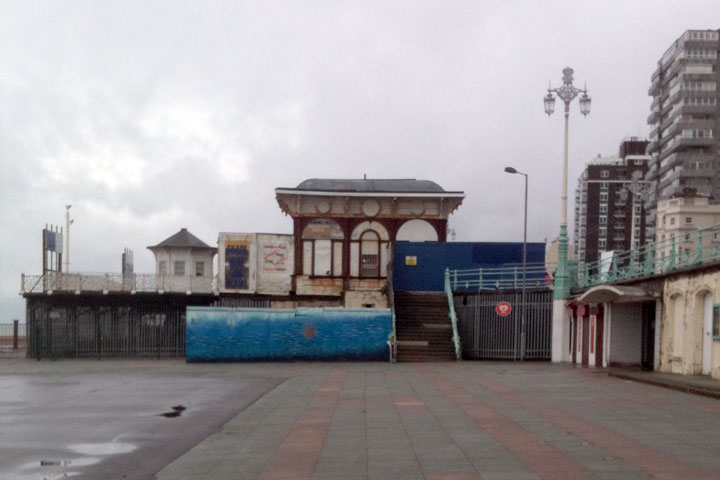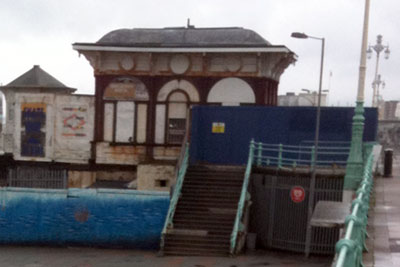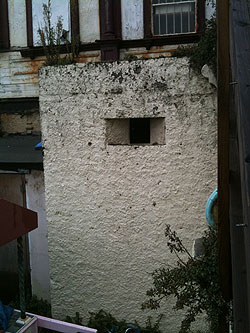Pier pillbox
Posted: 4 October 2010 12:08
Having been in Brighton yesterday for non-research purposes, I couldn't resist a quick trip to see a pillbox underneath the entrance to the old West Pier.
As I was travelling light, I didn't have my camera with me and so the poor-quality photos here are courtesy of my iPhone's camera.
The pillbox is just to the left of the steps above the wooden hoarding.


Although Brighton is part of East Sussex (for administrative purposes it's a unitary authority) it doesn't actually fall under the umbrella of the Defence of East Sussex Project because of military boundaries. In May 1940, it was in the East Sussex Divisional Area but by June was outside of it where it remained until a major shake-up of military boundaries in 1943. I therefore study the greater area of East Sussex that sat within a largely static boundary, roughly Telscombe Cliffs eastwards.
I do have some material relating to Brighton (accrued by accident rather than by design), but not enough to speculate much on who built this particular pillbox; it might have been a civilian contractor, but documents show that possibly the first Canadians to serve in East Sussex in 1940, (a Pioneer company) were constructing "MG and Bren posts" September - October 1940.

The close-up photo on the left shows a standard embrasure; given the location and the field of fire along the promenade and an exit ramp, I'm guessing there would have been a Bren gun team in here.
The area between the two piers (West Pier and Palace Pier) was of great importance and the following is an extract from a report in the National Archives regarding the defences on this stretch of seafront:
The two piers have been cut and the sea ends are prepared for demolition should the enemy attempt to use them. The land ends of the two piers are essential to the defences as where they jut out they are the only raised view of the whole length of intervening beach, between the sea and the upper promenade.
The German Befestigungskarte of this area records only a belt of barbed wire between the piers, although the pier demolitions and roadblocks up on the upper level of the promenade are marked. Given the location of this pillbox, the Germans might be forgiven for having missed this one, but I know of other pillboxes on the upper level also seemingly missed - perhaps an indication that they hadn't yet been built.
The pillbox is admittedly an odd survival - seaside towns were only too keen even before the cessation of hostilities to strip away the concrete and barbed wire and restore the grandeur of Georgian and Victorian seafronts in time for the first postwar tourist season. In this respect it is absolutely unique in East Sussex, as I know of no other example of a seafront pillbox on a promenade still extant.
- Pete

Email:
Blog Latest

Bishopstone reveals its pillbox secrets
18 October 2021

Pillbox or Observation Post?
10 June 2020

Uncovering the hidden secrets of a pillbox
8 June 2019

Review of 2018
31 December 2018

Wartime Christmas in East Sussex (2)
24 December 2018
Jargon-buster
Befestigungskarte
Fortifications map compiled by German Intelligence from aerial photographs during 1940-41 in preparation for Operation Sealion. Defence works were plotted using a system of red symbols.
Demolition
Term applied to a structure scheduled for demolition or already demolished. Walls and small buildings might be taken down to clear fields of fire or impede enemy passage by destroying a bridge. Some demolitions were not intended to be carried out until after invasion had begun, for example, certain bridges or road craters (pipe mines).
Embrasure
A loophole or slit that permits observation and/or weapons to be fired through a wall or similar solid construction.
Pillbox
Generic term for a hardened field defensive structure usually constructed from concrete and/or masonry. Pillboxes were built in numerous types and variants depending on location and role.
This site is copyright © Peter Hibbs 2006 - 2024. All rights reserved.
Hibbs, Peter Pier pillbox (2024) Available at: http://www.pillbox.org.uk/blog/216666/ Accessed: 25 April 2024
The information on this website is intended solely to describe the ongoing research activity of The Defence of East Sussex Project; it is not comprehensive or properly presented. It is therefore NOT suitable as a basis for producing derivative works or surveys!